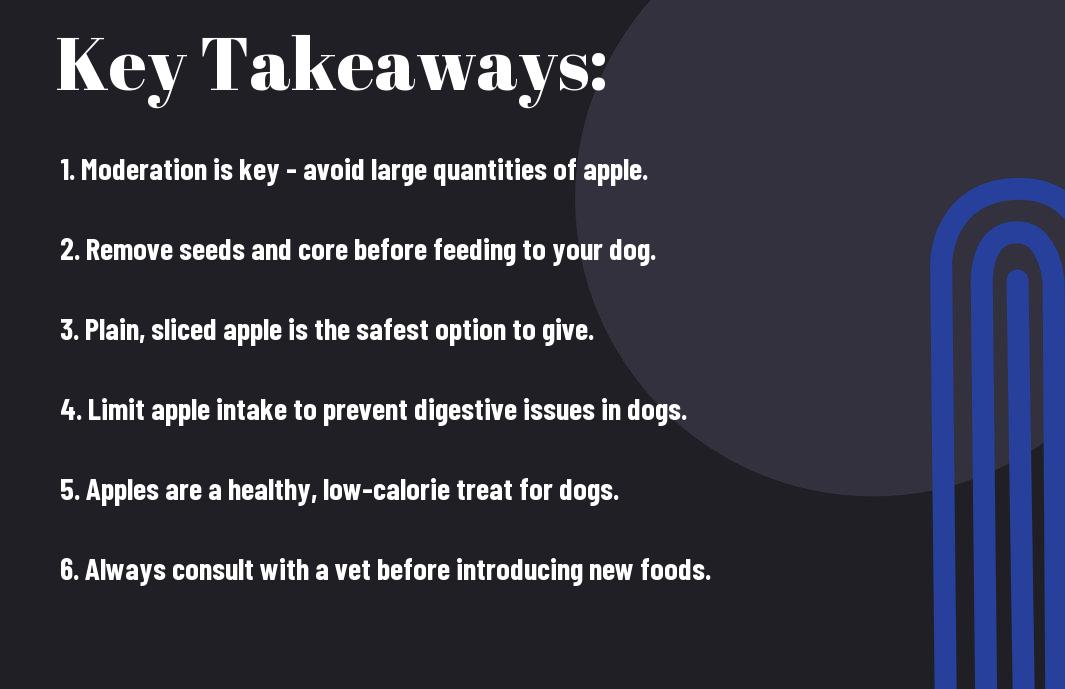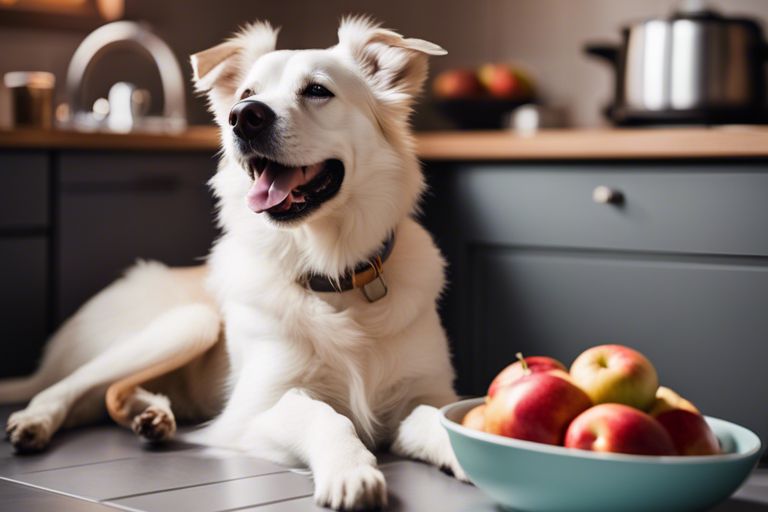Just how much apple can you give your dog, you may wonder with a puzzled jog. In this delightful, informative blog post, we’ll share with you the scoop, about giving your furry friend this fruit so juicy and sweet, without any mishap or achy pawed beat. Stay tuned as we unveil the amount, making sure your dog’s treat is just right, no need to pout or a pet parent’s plight.
Key Takeaways:
- Apples should be given to dogs in moderation: While apples are a healthy snack for dogs, too much can lead to digestive issues like upset stomach or diarrhea.
- Remove apple seeds and core: Only feed your dog apple slices without the seeds and core, as they contain cyanide which is toxic to dogs.
- Consult your vet: If you’re unsure about how much apple to give your dog or if your dog has any health conditions, it’s best to consult your vet for advice.
The Benefits of Apples for Dogs
Nutritional Value
One of the benefits of feeding your furry friend apples is their rich nutritional value. Apples are packed with crucial vitamins such as A and C, as well as dietary fiber. These nutrients can contribute to your dog’s overall health and well-being.
Dental Health
For dental health, apples can be a great natural solution. The crunchy texture of apples can help clean your dog’s teeth as they chew, reducing the buildup of plaque and freshening their breath.
This makes apples a healthy and delicious treat that not only nourishes your dog’s body but also promotes their dental hygiene. So, next time you reach for a snack, consider sharing a slice of apple with your loyal companion!
Potential Risks of Feeding Apples to Dogs
Choking Hazards
Hazards may arise when feeding apples to your furry friend, particularly due to the risk of choking. Apples contain seeds, stems, and cores that could pose a choking hazard to your dog. The seeds, in particular, contain amygdalin, which releases cyanide when chewed or digested, potentially causing serious harm.
Allergic Reactions
Risks of allergic reactions should also be considered when giving apples to your dog. While apples are not a common allergen for dogs, some can still have sensitivities. Allergic reactions can manifest as itchiness, gastrointestinal disturbances, or even difficulty breathing and should be monitored closely.
Dogs may experience adverse reactions when introduced to new foods, including apples. If you notice any signs of an allergic reaction, such as itching, swelling, or changes in behavior, consult your veterinarian immediately.
Digestive Issues
Reactions like diarrhea or upset stomach are other potential risks associated with feeding apples to your dog. Apples are high in fiber, which can lead to gastrointestinal upset, especially if your dog consumes a large amount or is not used to the fruit. It’s necessary to introduce apples gradually and monitor your dog for any digestive issues.
Allergic reactions or digestive issues can occur in some dogs when they consume apples. If your dog shows any signs of discomfort or illness after eating apples, it’s best to stop feeding them the fruit and consult with your veterinarian for guidance.
How Much Apple is Safe for My Dog?
After understanding that apples can be a healthy treat for your furry friend, you may be wondering how much you can safely give them. The amount of apple you can provide your dog can vary based on their size and breed. Here are some guidelines to help you determine the appropriate serving size for your canine companion.
Small Breeds (under 20 lbs)
Any small breed dog weighing under 20 lbs can enjoy a few small apple slices as a tasty snack. Make sure to remove the core and seeds before offering the apple to your pet. It’s recommended to start with a small amount to see how your dog reacts and monitor for any signs of digestive upset. Do not forget, moderation is key when introducing new foods to your dog’s diet.
Medium Breeds (20-50 lbs)
Much like small breeds, medium-sized dogs between 20-50 lbs can benefit from a moderate amount of apple in their diet. You can offer them slightly more apple compared to smaller breeds, but always watch for any adverse reactions. Apples can be a crunchy and delicious way to provide your medium-sized dog with additional nutrients and hydration.
Breeds such as Bulldogs, Cocker Spaniels, and Border Collies fall into this category and can enjoy apples in their diet as long as it’s given in appropriate portions.
Large Breeds (50-80 lbs)
Much like medium breeds, large dogs weighing between 50-80 lbs can also have a larger serving of apple as a healthy snack. These breeds, such as Labradors, Golden Retrievers, and Boxers, can benefit from the vitamins and fiber found in apples. However, always remember to cut the apple into bite-sized pieces and monitor your dog’s response to this new treat.
Breeds like German Shepherds, Rottweilers, and Standard Poodles fall into the large breed category and can enjoy apples in their diet in appropriate amounts.
Extra Large Breeds (over 80 lbs)
Medium to giant breeds weighing over 80 lbs, like Great Danes, Saint Bernards, and Mastiffs, can also have apple slices as a part of their diet. These dogs can handle a bit more apple due to their size, but it’s vital to introduce this fruit gradually to prevent any stomach upset. Remember to consult with your veterinarian if you have any concerns about incorporating apples into your extra large breed dog’s diet.
Another point to consider is that while apples can be a healthy and tasty treat for your dog, they should not replace their regular balanced meals. Always prioritize a complete and balanced diet for your furry friend and use apples as an occasional snack or training reward.
Preparing Apples for Your Dog
Once again, before giving your furry friend a delicious treat like apples, it’s imperative to know how to prepare them properly. For detailed information on whether dogs can eat apples and what you should consider, you can check out Can Dogs Eat Apples? What You Need to Know.
Washing and Peeling
To ensure that the apples you give your dog are clean and free of any residues, it’s advisable to wash them thoroughly under running water. While apple skin is safe for dogs to consume, peeling the apple might be a good idea if your pup has a sensitive stomach or struggles with digesting the skin.
Removing Seeds and Cores
Removing the seeds and cores from the apples is crucial before sharing them with your dog. Apple seeds contain cyanide, which can be toxic to dogs if consumed in large quantities. It’s best to core the apple and remove any seeds to eliminate this risk.
Apples are a healthy and tasty snack for your furry companion, but it’s imperative to take precautions to ensure their safety and well-being.
Slicing or Dicing
Your dog might enjoy apples in different shapes and sizes, depending on their preferences. Slicing or dicing the apples into smaller pieces can make it easier for your pup to chew and digest them. It also helps in portion control, especially if you have a small breed dog.
It’s imperative to adjust the size of the apple pieces according to your dog’s breed and chewing capabilities. Always supervise your dog while they’re enjoying their apple treat to prevent any choking hazards.
Healthy Alternatives to Apples
Many pet owners wonder what other fruits and vegetables they can safely share with their furry friends after learning about the benefits of apples for dogs. If you are curious about expanding your dog’s snack options, you may want to explore some healthy alternatives. For more information on safe fruits like apples for dogs, you can check out this informative article on Can Dogs Eat Apples? Everything You Need to Know.
Carrots
Alternatives to apples for your furry friend include crunchy and vitamin-packed carrots. Dogs often enjoy the satisfying crunch of raw carrots, and the beta-carotene they contain can benefit their vision and skin health. You can offer your dog baby carrots as a low-calorie treat or mix grated carrots into their food for a nutrient boost.
Green Beans
Healthy green beans are another excellent alternative to apples that you can share with your canine companion. These veggies are rich in fiber and low in calories, making them a great choice for dogs watching their weight. You can steam or boil green beans for a soft texture, or offer them raw for a satisfying crunch.
A great way to introduce green beans is by incorporating them into your dog’s regular meals. You can mix them with other veggies and protein sources for a balanced and nutritious dish your pup will love.
Sweet Potatoes
Carrots are an excellent alternative to apples for your dog, and they can also enjoy nutrient-dense sweet potatoes. These root vegetables are packed with vitamins and fiber, promoting digestive health and offering a sweet flavor that many dogs find irresistible. You can bake or steam sweet potatoes and serve them as a tasty snack or mix them into your dog’s meals for added nutrition.
Understanding
By exploring various healthy alternatives to apples, you can add diversity to your dog’s diet and provide important nutrients to support their well-being. Remember to introduce new foods gradually and monitor your dog for any signs of sensitivity or allergies. Consult with your veterinarian if you have any concerns about introducing new fruits and vegetables to your dog’s diet.
Common Mistakes to Avoid
Overfeeding
Now, when it comes to feeding your dog apples, it’s vital not to overdo it. While apples are a healthy treat for your furry friend, feeding them in excess can lead to stomach upset and diarrhea. Do not forget, moderation is key!
Feeding Apples with Pesticide Residue
To avoid potential health risks, make sure to wash apples thoroughly before feeding them to your dog. Pesticides left on the skin can be harmful to your pet. Opt for organic apples whenever possible to minimize the risk.
Feeding your dog apples with pesticide residue can expose them to harmful chemicals that could potentially cause health issues. As a responsible pet owner, prioritize your dog’s well-being by choosing organic apples or properly washing conventional ones before sharing them.
Not Monitoring Your Dog’s Reaction
Dogs can have varying reactions to new foods, including apples. It’s important to monitor your dog after feeding them apples for the first time. Watch out for any signs of allergic reactions or gastrointestinal distress. If you notice any adverse effects, stop feeding them apples immediately and consult your veterinarian.
Avoid the mistake of not paying attention to your dog’s reaction when introducing apples into their diet. Every dog is different, and some may have sensitivities or allergies to certain foods. By being observant and responsive to your dog’s cues, you can ensure their well-being and enjoyment of this tasty snack.
To wrap up
Now, you know that apples can be a healthy and tasty treat for your furry friend, but it’s important to keep the portion size in check. Bear in mind, moderation is key when feeding apples to your dog. Stick to small slices or chunks of apple and always remove the seeds and core to prevent any potential harm. By following these simple guidelines, you can safely incorporate apples into your dog’s diet as an occasional snack that provides crucial nutrients and a crunchy texture they’ll love.
FAQ
Q: How much apple can I give my dog?
A: For a dog, a slice or two, will do. But remember, too much can cause a tummy ache, so moderation is the key to take!
Q: Can dogs eat apple skin?
A: Oh yes, they can, it’s safe and grand. Just make sure it’s washed clean, for your furry friend.
Q: Are there any benefits to giving my dog apples?
A: Indeed, there are benefits galore, for your pup to adore. Apples are a tasty treat, packed with vitamins and fiber that can’t be beat!
Q: Can apple seeds be harmful to dogs?
A: Ah, beware of apple seeds, for they contain cyanide, a harmful misdeed. Remove the seeds before feeding, to keep your dog’s health succeeding!
Q: How should I serve apples to my dog?
A: Sliced or chopped, it’s all good. Just remove the core and seeds, as you should. Fresh or frozen, as a snack or in a treat, your dog will think it’s a delicious feat!
The Top Dog Breeds Recognized by the American Kennel Club




